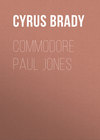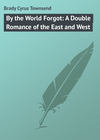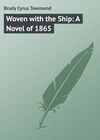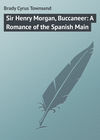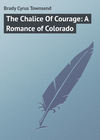Читать книгу: «Commodore Paul Jones», страница 25
APPENDICES
APPENDIX I
CONCERNING JOHN PAUL'S ASSUMPTION OF THE NAME OF JONES
A
Letter of Mr. W. M. Cumming, of Wilmington, N. C., May 21, 1899
"John Paul adopted the name of Jones in token of affectionate regard for the Honorable Willie (pronounced Wylie) Jones, of North Carolina, and his beautiful and charming wife, who had both been very kind to him in his days of obscurity. He was particularly devoted to Mrs. Jones, and called himself her son. It was through the influence of Honorable Willie Jones (member of Congress, I think, from North Carolina), that John Paul obtained his commission in the navy of the young Republic, and it was about this time that he adopted the name of his friend and patron."
B
Letter of Mr. Junius Davis, of Wilmington, N. C., February 23, 1900
"I first heard from my father, the late Hon. George Davis, who was a devoted student of the history of North Carolina, and perhaps the highest authority in the State upon such subjects, that Paul, shortly after going to Virginia to take the estate left him by his brother, met Willie Jones of this State; that Jones took a fancy to him and invited him to pay him a visit in North Carolina; that Paul did so and remained quite a long time with him and became so attached to Jones and his wife that he adopted their name. Willie-pronounced Wylie-Jones and his brother Allan were educated at Eton, and were gentlemen of large means, high ability, and devoted Whigs. They were prominent in every movement and assembly in this State prior to and during the Revolution. Allan lived upon his plantation, 'Mount Gallant,' in Halifax County, and Willie upon his, 'The Grove,' in the adjoining county of North Hampton. They were warm friends and associates of Joseph Hewes, of Edenton, one of the delegates from North Carolina to the first and second Provincial Congresses. Wheeler, the historian of North Carolina in his Reminiscences and Memoirs of North Carolina and Eminent North Carolinians, says as follows:
"'The daring and celebrated John Paul Jones, whose real name was John Paul, of Scotland, when quite young visited Mr. Willie Jones at Halifax, and became so fascinated with him and his charming wife that he adopted their family name. Under this name, John Paul Jones, he offered his services to Congress and was made a lieutenant, December 22, 1775, on the recommendation of Willie Jones.' … Jones in the very outset of his Autobiography says: 'I at the same time acquainted Mr. Hewes, a member of Congress and my particular friend, with the project for seizing the island of St. Helena,' etc. This is the Mr. Hewes mentioned above. In the second Congress Hewes was at the head of the committee in charge of naval affairs, and was virtually the first Secretary of the Navy. Paul could only have known Hewes, whom he calls his particular friend, through the Joneses, and it has always been one of the traditions of this State that it was the Jones influence with Hewes that got Paul his lieutenancy in the American navy. In a letter received recently from my aged kinsman, Colonel Cadwallader Jones, of Rock Hill, South Carolina, a lineal descendant of Allan Jones, I find that Colonel Jones' mother was a granddaughter of General Allan Jones, was raised by him, married in 1810, and lived in Halifax until 1826. Up to this time she was a frequent visitor at 'The Grove,' the residence of Willie Jones, as was also Colonel Cadwallader Jones. The latter, who is now eighty-six years of age, has always heard that John Paul assumed the name of Jones as a mark of respect and affection for these brothers, Willie and Allan Jones, and for the wife of the former, whose virtues might well win the admiration of any man. Colonel Jones remembers his aunt, Mrs. Willie Jones, perfectly; she survived her husband many years. The statement that John Paul was invited by Willie Jones to visit 'The Grove' while he was looking after his property in Virginia is corroborated by Colonel Jones… I quote the following from newspaper clippings:
"1. From the Charleston Observer of November, 1899:
"'Fredekicksburg, Va., November 18th.
"'The announcement that the remains of that distinguished naval hero, John Paul Jones, have been located in Paris, France, brings to light that the deceased was once a resident of this city. According to the records of the county court, he came here in 1773 to administer on the records of his brother, William Paul, who lived here in 1772. William Paul came here in 1760 and shortly afterward entered the mercantile business, in which he was engaged up to the time of his death. The store occupied by him is on the corner of Main and Market Streets, and is the same building in which George Washington was made a Mason. Tradition also says that one of the rooms in the building was used by John Paul during his residence here, which was nearly two years, as his lodging quarters. It was also during his citizenship here that he received his appointment from the Colonial Congress as lieutenant in the navy. It was here, too, that he added Jones to his patronymic, which, it is said, was in token of the friendly act of Colonel Willie Jones, of North Carolina, who became his bondsman for five hundred pounds when he administered on his brother's estate.'
"2. The State, Columbia, S. C., Monday, November 6, 1899:
"'Saratoga, Buckingham County, Va., February 22,1899.
"'… While no Revolutionary biography can boast more public events of vivid and intense interest than that of Paul Jones, none is so bare and meager in personal detail. Even the fact that he has immortalized a name which was his only by selection and adoption is slurred over in history with the calm statement that "he changed his name for unknown reasons." As the reasons were not unknown, and, however difficult to obtain later, were then easily accessible, it appears to have been rather a lack of careful and intelligent investigation than of facts which caused their suppression. They are now for the first time given to the public… In 1773, the death of his brother in Virginia, whose heir he was, induced him to settle in America. It was then he added to his name and thenceforth was known as "Paul Jones." This was done in compliment to one of the most noted statesmen of that day, and in the love and gratitude it shadows forth is a scathing reproach and a touching example to a people who could neglect in life and forget in death. It appears that before permanently settling in Virginia, moved by the restlessness of his old seafaring life, he wandered about the country, finally straying to North Carolina. There he became acquainted with two brothers, Willie and Allan Jones. They were both leaders in their day, and wise and honored in their generation. Allan Jones was an orator and silver-tongued; Willie Jones, the foremost man of his State, and one of the most remarkable of his time…
"'His home, "The Grove," near Halifax, was not only the resort of the cultivated, the refined, but the home of the homeless, Mrs. Jones having sometimes twenty orphan girls under her charge, and it was here the young adventurer, John Paul Jones, was first touched by those gentler and purer influences which changed not only his name but himself, from the rough and reckless mariner into the polished man of society, who was the companion of kings and the lion and pet of Parisian salons. The almost worshiping love and reverence awakened in his hitherto wild and untamed nature by the generous kindness of these brothers found expression in his adoption of their name. The truth of this account is … attested by the descendants of Willie Jones.
"'In addition to the above, I would say that General Allan Jones of the Revolution was my great-great-grandfather. My grandmother was raised by him, and was often at "The Grove," the residence of her great-uncle, Willie Jones. My father, Colonel Cadwallader Jones, now eighty-six years of age, in his youth was also often an inmate of "The Grove," and heard the facts spoken in both families.
"'A. I. Robertson,"'Secretary Columbia Chapter, D. A. R.'"
C
Letter of Mrs. A. I. Robertson, of Columbia, S. C.,April 14, 1900
"John Paul was thrown more with Mr. and Mrs. Willie Jones, I think, than Allan, as he was more at 'The Grove' (the residence of Willie Jones) than at 'Mount Gallant' (the residence of Allan Jones), though a great deal at both places. I have an exact facsimile of the commission which these brothers got for him, which appeared in the World, February 11, 1900.
"Mrs. Allan Jones was Mary Haynes, married 1762; their daughter Sarah married General William R. Davis.
"Mrs. Willie Jones was Mary Mumford, daughter of Joseph Mumford, son of Robert Mumford and wife Anne, daughter of Robert Bland. These two Mrs. Jones are spoken of in Mrs. Elliot's Women of the Revolution, Wheeler's History of North Carolina, and Appletons' Cyclopædia of American Biography.
"I quote you the following from the family book of my father: 'When the army of Cornwallis passed through Halifax to Virginia, his officers quartered for some time in the town. Colonel Tarleton was at "The Grove," the residence of Willie Jones. He had been wounded in the hand at Cowpens by a sabre cut by Colonel William Washington. Speaking of Colonel Washington, Tarleton said he was a common, illiterate fellow, hardly able to write his name. "Ah, colonel," said Mrs. Jones, "you ought to know better, for you bear upon your person proof that he knows very well how to mark his mark."' I inclose a MS. of my father on the subject, which you are at liberty to copy."
MS. of Colonel Cadwallader Jones inclosed in above Letter
"Paul Jones-Why he changed his name-Colonel Hubard's account.
"A recent sketch of the life of Paul Jones in the Century has revived the memory of his gallant achievements, and rekindled public interest in this famous hero. There is much inquiry as to his reason for adopting the name of Jones. It is not a little remarkable that such an incident in the life of one so renowned should be so soon forgotten.
"Let me tell you what I know about this man and how I know it; the public mind needs to be refreshed. When John Paul came to Virginia, some three years before the war of the Revolution, looking after an estate left him by his brother, he visited Halifax, North Carolina, at that time a place of considerable repute. Here he made the acquaintance of those grand old patriots, Allen and Willie Jones; he was a young man but an old tar, with a bold, frank sailor bearing that attracted their attention; he became a frequent visitor at their homes, where he was always welcome; he soon grew fond of them, and as a mark of his esteem and admiration, he adopted their name. Why John Paul became John Paul Jones-it was his fancy…"
D
Letter of General Edward McCrady, of Charleston, S. C.,April 3, 1900
"Mrs. McCrady was the granddaughter of General William R. Davie, of Revolutionary fame, who married the daughter of General Allan Jones, of Mount Gallant, Northampton, North Carolina. Tradition in her branch of the family has been that it was Allan Jones who befriended John Paul, and not his brother Willie-pronounced Wylie, not Willie. It was in honor of Allan Jones that he adopted the name of Jones as surname to that of Paul…"
E
In a subsequent letter from Mr. Junius Davis, Wilmington, North Carolina, dated April 24, 1900, he writes as follows:
"In respect to the name of Jones, I never heard the question raised in the State as to whether Willie or Allan was the man, who, as it were, picked up John Paul and was his closest friend. Beyond all question, Willie was the man, but above Willie in the affection of John Paul was Mrs. Willie Jones. Undoubtedly it was his affection for her that induced him to change his name. She was a Miss Montford, daughter of Colonel Joseph Montford, and had a sister who married Colonel John Baptiste Ashe, a distinguished soldier of this State, during the war of the Revolution. In regard to the retort made by Mrs. Willie Jones to Tarleton, you will find it mentioned in Mrs. Elliot's Women of the Revolution. It is also mentioned by Wheeler in vol. ii, page 186, of his History of North Carolina. It is a little singular that Mrs. Ashe, sister of Mrs. Willie Jones, also retorted upon Tarleton. On one occasion, when he said with a sneer that he would like to meet Colonel Washington, she replied, 'If you had looked behind you at the battle of Cowpens you would have had that pleasure.' These two ladies were both very beautiful women, highly gifted in mind and character, and highly educated."
F
On this subject see also Appletons' Cyclopædia of American Biography, vol. iii, under Jones.
APPENDIX II
CONCORDAT MADE BETWEEN CAPTAIN JOHN PAUL JONES AND THE OFFICERS OF THE SQUADRON
"Agreement between Messieurs John Paul Jones, captain of the Bon Homme Richard; Pierre Landais, captain of the Alliance; Dennis Nicholas Cottineau, captain of the Pallas; Joseph Varage, captain of the Stag; and Philip Nicholas Ricot, captain of the Vengeance; composing a squadron that shall be commanded by the oldest officer of the highest grade, and so in succession in case of death or retreat. None of the said commanders, while they are not separated from the said squadron, by order of the minister shall act but by virtue of the brevet, which they shall have obtained from the United States of America, and it is agreed that the flag of the United States shall be displayed.
"The division of the prizes to the superior officers and crews of said squadron, shall be made agreeable to the American laws; but it is agreed that the proportion of the whole coming to each vessel in the squadron shall be regulated by the Minister of the Marine Department of France, and the Minister Plenipotentiary of the United States of America.
"A copy of the American laws shall be annexed to the present agreement, after having been certified by the commander of the Bon Homme Richard; but, as the said laws can not foresee or determine as to what may concern the vessels and subjects of other nations, it is expressly agreed that whatever may be contrary to them should be regulated by the Minister of the French Marine, and the Minister Plenipotentiary of the United States of America.
"It is likewise agreed that the orders given by the Minister of the French Marine, and the Minister Plenipotentiary of the United States be executed.
"Considering the necessity there is of preserving the interests of each individual, the prizes that shall be taken shall be remitted to the orders of Monsieur le Ray de Chaumont, honorary intendant of the Royal Hotel of Invalids, who has furnished the expenses of the armament of the said squadron.
"It has been agreed that M. le Ray de Chaumont be requested not to give up the part of the prizes coming to all crews, and to each individual of the said squadron, but to their order, and to be responsible for the same in his own and proper name.
"Whereas the said squadron has been formed for the purpose of injuring the common enemies of France and America, it has been agreed that such armed vessels, whether French or American, may be associated therewith by common consent, as shall be found suitable for the purpose, and that they shall have such proportion of the prizes which shall be taken as the laws of their respective countries allow them.
"In case of the death of any of the before-mentioned commanders of vessels, he shall be replaced agreeably to the order of the tariff, with liberty, however, for the successor to choose whether he shall remain on board his own vessel, and give up the next in order, the command of the vacant ship.
"It has, moreover, been agreed, that the commander of the Stag shall be excepted from the last article of this present agreement, because in case of a disaster to M. de Varage he shall be replaced by his second in command, and so on by the other officers of his cutter, the Stag.
"J. Paul Jones."P. Landais.
"De Cottineau. "De Varage.
"Le Ray de Chaumont."P. Ricot."
APPENDIX III
ON THE FLAG OF THE BON HOMME RICHARD
The statement is frequently made that the flag under which the Bon Homme Richard fought the Serapis is still in existence, and the following letter from the assistant secretary of the Smithsonian Institution gives a history of the claim:
"I am authorized by the secretary to acknowledge the receipt of and reply to your letter of the 27th instant, in which you ask whether the identical flag used by John Paul Jones on the Bon Homme Richard is the one now in the custody of the Smithsonian Institution.
"Your letter has been referred to Mr. A. H. Clark, Custodian of the Section of American History in the National Museum, who has submitted the following facts, which I submit to you as the opinion of this institution in the case."
"'The evidence appears conclusive that the flag in the National Museum is the identical one used by John Paul Jones on the Bon Homme Richard. This flag was presented to James Bayard Stafford in 1784, by the Marine Committee, with the following letter. The sword and musket are exhibited with the flag together with the original letter:
"'"Philadelphia, Monday, December 13, 1784.
"'"James Bayard Stafford.
"'"Sir: I am directed by the Marine Committee to inform you that on last Thursday, the 9th, they decided to bestow upon you, for your meritorious service thro' the late war, Paul Jones' Starry Flag of the Bon Homme Richard-which was transferred to the Alliance-a boarding sword of said ship, and a musquet captured from the Serapis.
"'"If you write to Captain John Brown, at the Yard, what ship you wish them sent by to New York, they will be forwarded to you.
"'"Your humble servant,
"'"James Meyler,
"'"Secretary, pro tem."
"'In the United States Senate, May 1, 1872, the Committee on Revolutionary Claims favorably reported a bill (S. 1060) for payment to Sarah S. Stafford, for the services of her father, James Bayard Stafford, an officer of the Revolution. In the committee's report, Commodore Barry, of the Alliance, certified to the service of Lieutenant Stafford, and the report further states that "it fully appears from the testimony before the committee that James Bayard Stafford entered the navy at the beginning of the War of Independence, and was in constant and active service, and in frequent battles, and remained in the service until the close of the war; that his ship was captured by a British cruiser, and subsequently recaptured by John Paul Jones, when he volunteered on the Bon Homme Richard, where he received wounds, which, owing to unskillful treatment, broke out after a time, disabling both his arms."
(Signed.) "'A. H. Clark,
"'Custodian, Section of American History,
United States National Museum.'
"Yours very respectfully,
(Signed.) "Richard Rathbun,
"Assistant Secretary."
This is an opinion with which I must disagree. Stafford, it is claimed, had been a sailor in the American armed ship Kitty, which had been captured by a British cruiser, said cruiser and her prize being subsequently taken by the Richard, whereupon Stafford volunteered for service on the Richard, was warranted a midshipman, and is alleged to have performed several heroic deeds in connection with the flag during the action.71 There is no authority whatever for any of these statements in any existing contemporary account of the battle, yet the occurrence was sufficiently important to be mentioned somewhere, surely, if it had occurred. Stafford's name does not appear in any of the lists of the officers and crew, and the Richard certainly did not capture any British cruiser and her prize. But we have evidence which is more than negative, for Jones explicitly states that when the Richard went down, a flag-presumably that which had been shot from the staff, or had fallen with it, during the action, and had been recovered the next day-was left flying at the peak. In subsequent letters, though, he takes occasion to refer specifically to the fact that he sailed under American colors in the Alliance-he calls them "my very best American colors," a phrase certainly inappropriate for the battle-torn ensign of the Richard-he never makes the slightest reference to their having been used in the famous battle. Again, the Alliance sailed finally under the command of Landais, and no mention of any particular flag appears thereafter. It may be possible, however, though doubtful, that the flag which was given to Stafford was the "best American colors" under which Jones sailed from the Texel, and, if so, it is an interesting relic. The last circumstance that militates against the claim is the size of the flag in question. It is so small that it is highly improbable it was ever used for a battle flag!

